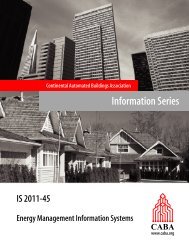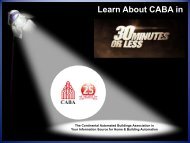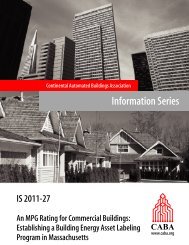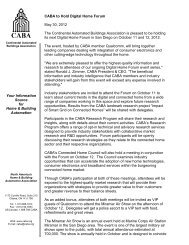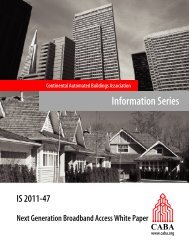The Future Building Management System - Continental Automated ...
The Future Building Management System - Continental Automated ...
The Future Building Management System - Continental Automated ...
Create successful ePaper yourself
Turn your PDF publications into a flip-book with our unique Google optimized e-Paper software.
CABA’s Intelligent & Integrated <strong>Building</strong>s Council (IIBC) focused on areas of research that address the needsand priorities of high performance and intelligent buildings. <strong>The</strong> IIBC identified two key areas of explorationin its 2011 Landmark Research study - the impact of smart grid development on intelligent buildings, andthe progression of intelligent buildings towards net zero energy.<strong>The</strong>re is a growing marketplace outlook that achieving energy sustainability and the growth of building intelligence are interdependentand exert a collective influence in the progression of high performance intelligent buildings. Consequently, CABA’s IIBC members focussedthe research study on an investigation and assessment of the impact of the smart grid on the commercial buildings sector. Though stillearly in development and deployment, the research also examined the relationship of smart grids and the progression towards net zeroenergy output in intelligent buildings.<strong>The</strong> purpose of this study was to identify, define and size the principle business opportunities presented by the growth of smart grids, inrelation to “intelligent buildings”. An examination of smart grid should yield immediate value to all stakeholders in the intelligent buildingindustry, as smart grid and auto demand response holds more relevance in the industry today - with opportunities in existing buildingsand new construction. Energy capacity/supply problems need to be addressed in the short-term, and made available in emerging technology.This will serve to add to market education and understanding, and address market knowledge gaps. As well, open and interoperablecommunication between energy suppliers and commercial energy users is an eventuality - which was further explored in relation tosmart grid development and intelligent buildings. <strong>The</strong> purpose of these initiatives is two fold – an educational and validation exercisefor industry participants and a means to drive public opinion and facilitate policy decisions at industry stakeholder, public authority andgovernment organization levels.<strong>The</strong> study was funded by these CABA members:RUBY SPONSOREMERALD SPONSORSDIAMOND SPONSORS<strong>The</strong> research was undertaken by research and buildings technology consultancy, BSRIA, on behalf of CABA.Your Information Source ForHome & <strong>Building</strong> Automationwww.CABA.orgTo purchase this and other available research reportsor explore new research opportunities contact:George GrimesCABA Business Development Manager613.686.1814 x226 or grimes@caba.orgMore Information available at:www.caba.org/estore
the magazine of the continentalautomated buildings associationautumn 2012 volume 9, number 3FeaturesLarge <strong>Building</strong> Automation........................................................................................................................................................... 10<strong>The</strong> <strong>Future</strong> <strong>Building</strong> <strong>Management</strong> <strong>System</strong> by Jim SinopoliHome <strong>System</strong>s........................................................................................................................................................................................ 7Home Automation for the Masses by John AntonchickCOLUMNSPresident & CEO’s Message............................................................................................................................................................ 3CABA Research Briefs........................................................................................................................................................................ 5<strong>The</strong> <strong>Future</strong> of the Electric Grid – An Interdisciplinary MIT Study<strong>The</strong> Potential of Smart Meter Enabled Programs to Increase Energy and <strong>System</strong>s Efficiency:A Mass Pilot ComparisonKen Wacks’ Perspectives............................................................................................................................................................... 12International Standards for Smart GridsResearch Viewpoints........................................................................................................................................................................ 16CABA Unveils New Market Research Initiatives by Rawlson O’Neil KingOpinion..................................................................................................................................................................................................... 18Integrated <strong>System</strong>s Are A “Must Do” Requirement by Frank BisbeeDepartmentsNew Members.......................................................................................................................................................................................... 4Industry Trends.................................................................................................................................................................................... 17Networking and Outreach............................................................................................................................................................... 20Upcoming Events................................................................................................................................................................................ 21CABA NewsBriefPlease go to the CABA Web site at www.caba.org tolearn how to freely subscribe and sponsor
Editorial Advisory BoardDr. Kenneth WacksKen Wacks Associates (Chair)David LabuskesRTKL Associates, Inc.Labib MattaNeXgen Advisory Group FZ-LLCDaniel MichaudEnvironmental <strong>System</strong>s DesignHarshad ShahEagle Technology, Inc.Managing EditorRonald J. Zimmer, CAEEditorRawlson O’Neil KingContributorsKen GallingerGeorge GrimesJohn HallAssociation Office<strong>Continental</strong> <strong>Automated</strong> <strong>Building</strong>sAssociation1173 Cyrville Road, Suite 210Ottawa, Ontario, CanadaK1J 7S6Tel: 613.686.1814; 888.798.CABA (2222)Fax: 613.744.7833Further editorial use of the articles in thismagazine is encouraged.For subscriptions, circulation, and change ofaddress enquiries email caba@caba.org. Foreditorial and advertising opportunities:www.caba.org/ihomesandbuildingsJoin CABA Today!<strong>The</strong> <strong>Continental</strong> <strong>Automated</strong><strong>Building</strong>s Association providesmore information about integratedsystems and automation in homesand buildings than any othersource.www.caba.org<strong>The</strong> views expressed in this magazine arenot necessarily those held by the <strong>Continental</strong><strong>Automated</strong> <strong>Building</strong>s Association (CABA). CABAshall not be under any liability whatsoever withrespect to the contents of contributed articles.<strong>The</strong> organization reserves the right to edit,abridge or alter articles for publication.2iHomes & <strong>Building</strong>s
CABA Board of DirectorsChairDr. Satyen MukherjeePhilipsVice-ChairDr. Morad AtifNational Research CouncilCanadaDirectorsScot AdamsCadillac Fairview CorporationKris BowringBest Buy Co., Inc.Scott BurnettIBMBrian CaseyHoneywell International, Inc.Dr. Yong ChangSamsung Electronics, Co. Ltd.Michael ClayVerizon WirelessJonathan ClutsMicrosoft CorporationLarry EhlingerPella CorporationJeff HamiltonIngersoll RandBill HorrocksComcast CommunicationsTerrie IpsonDiebold IncorporatedElizabeth JacobsSiemens Industry, Inc.Shahram MehrabanIntel CorporationIan MilneRobinson SolutionsMike NagerMetz ConnectStephen NardiRealView, LLCBarry RogersSecurTek MonitoringSolutionsTom SemlerHydro One Networks Inc.Alok SinghSouthern California EdisonCompanyDana “Deke” SmithNational Institute of <strong>Building</strong>Sciences<strong>The</strong> CABA Board of Directors made an important decision approximately seven yearsago. In their strategic planning efforts, they decided that CABA should become an internationaltrade association. <strong>The</strong> reality then, as it is today, is that integrated systemsfor homes and buildings are rapidly expanding globally. Technology today is being developedand deployed for connected homes and intelligent buildings worldwide.CABA’s efforts have evolved to ensure that the research and information, that isgathered and disseminated, is truly international. <strong>The</strong> CABA Research Library has grownto over 1,000 publications and is now the largest library of its kind in the world. Researchmaterial from virtually every continent is being gathered, reviewed by the CABA InformationCouncil, and added to CABA.As a result, more than 25,000 industry professionals have access and utilize thisresearch and information. More than 320 companies and organizations that are CABAmembers are not just North American, but many are multinational and their representativesare worldwide. Many more people access the free CABA Public Library, Web siteand share info in the CABA Group on LinkedIn.CABA representatives are increasinglybeing invited and have presented industry researchat many industry events, not just in theU.S. and Canada, but in countries such as: Mexico,Hong Kong, Estonia, Korea, China, Russia, SaudiArabia, Taiwan, France and Netherlands. Mostrecently, CABA research was presented in Brazilat the SASBE 2012 and XI edição do CongressoHabitar.CABA collaborates and liaises with many“sister” associations throughout the world inorder to grow this sector faster. It was greatto work with AURESIDE – Brazilian HomeAutomation Association and attend their conference, along with representatives fromKNX and Z-Wave Alliance. CABA is truly an international trade association and willcontinue to help the industry grow!Remember – CABA works for you and the industry!CABA President & CEO’sMessageRon ZimmerRon Zimmer, CABA President & CEO withBent Sorensen of the Z-Wave Alliance,Heinz Lux, KNX Association and JoséRoberto Muratori of AURESIDE (left toright)Autumn 20123
New Members<strong>The</strong> <strong>Continental</strong> <strong>Automated</strong> <strong>Building</strong>s Association is a not-for-profitindustry association that promotes advanced technologies for theautomation of homes and buildings. CABA members benefit from timely,competitive intelligence on the integrated systems industry. Here is asampling of our latest members.Anixter CanadaAnixter Canada is a leading global supplier of communications and security products, electrical and electronic wire andcable, fasteners and other small components.Honda Environmental Business Development Office<strong>The</strong> Honda Environmental Business Development Office is responsible for Honda’s new environmental technology andbusiness initiatives in the U.S.LumenCacheLumenCache provides technology that replaces traditional 110V AC power distribution in buildings with a new standardmore appropriate to the low power needs and digital capabilities of LED lights.QA GraphicsQA Graphics is an innovative graphic development company specializing in control system graphics for the buildingautomation industry. <strong>The</strong> company is an industry leader in the design of system graphics, energy dashboards, 3-D design andanimation, and drafting services.Tendril NetworksTendril is an energy platform company that delivers end-to-end consumer engagement products, applications and services.TRLabsTRLabs is Canada’s largest information and communications technology (ICT) research and development consortium. Asan innovation performer, TRLabs fast tracks innovation to market by working with industry, government, and academicpartners to discover, develop and commercialize technology.A complete CABA member listing with both product and service information and Web links is available at:www.caba.orgConnect With Us at www.caba.org4 iHomes & <strong>Building</strong>s
CABA RESEARCH BRIEFSCABA Research Briefs provide a condensed synopsis of specific researchpapers available in the organization’s research libraries. CABA researchlibraries provide industry intelligence to the home and large buildingautomation and integrated systems sector.<strong>The</strong> <strong>Future</strong> of the Electric Grid – An Interdisciplinary MIT StudyThis report, the fifth in the MIT Energy Initiative’s “<strong>Future</strong> of” series, aims to provide a comprehensive, objectiveportrait of the U.S. electric grid and the identification and analysis of areas in which intelligent policy changes, focusedresearch, and data development and sharing can contribute to meeting the challenges the grid is facing. It reflects afocus on integrating and evaluating existing knowledge rather than performing original research. Authors hope it willbe of value to decision makers in industry and in all levels of government as they guide the grid’s necessary evolution.<strong>The</strong> report identifies the challenges and suggests valuable recommendations for resolving them with an aim of areliable, efficient, effective, scalable and customizable smart electric grid.Figure 9.1 – Diagram of the <strong>Future</strong> Electric Grid, Showing Communications and Power FlowsSecure Communication FlowsElectrical FlowsDomainMarketsOperationsServiceProviderBulkGenerationCustomerTransmissionDistributionSoure: National Institute for Standards and Technology, NIST Framework and Roadmap for Smart Grid Interoperability Standards, Release1.0, special publication 1108 (Washington, DC: U.S. Department of Commerce, 2010), 33, http://www.nist.gov/public_affairs/releases/uploads/smartgrid_interoperability_final.pdfAutumn 20125
caba research briefs<strong>The</strong> Potential of Smart Meter Enabled Programs to Increase Energy and <strong>System</strong>s Efficiency: A Mass Pilot ComparisonThis report by VaasaETT Global Energy Think Tank summarizes the findings of 100 consumption reduction pilots inhomes involving 450,000 consumers from Europe, USA, Canada, Japan and Australia. <strong>The</strong> report assessed these pilotsin three general areas: energy conservation, peak clipping and bill reduction.In-house displays (IHD) are displays that hang on the wall or sit on a counter and provide close to real time informationabout household electricity consumption. <strong>The</strong>y also provide a variety of other data. For example, the displayprovided in the “Electricity Smart Metering Customer Behavior Trials” (see figure below) allows people to set dailybudgets for how much they want to spend, informs them of their success, what the current price of electricity is andprovides information on how much they have spent so far this month.In Home Display (IHD)Shows how you are doing againstyour daily budgetIndicates the current cost ofelectricity per hour (does notinclude standing charge and VAT)Indicates how much yourelectricity has cost this month(does not include standing chargeand VAT)Indicates price at peak (red), day(organge) and night (green) ratesIHDs provide households with real-time and historical information on their electricity usage and costs. Additionalfeedback-content that is sometimes offered on the IHD includes peer comparisons (showing the consumption rateof neighbors or consumers with similar conditions), and appliance specific consumption (breaking down the energyusage of individual appliances in the home). <strong>The</strong> home screen for the dynamic display unit is the key screen that thecustomer always sees when the device is switched on, while further information can be gained if desired throughnavigating to other screens.Ambient displays differ from IHDs in that they do not provide specificconsumption information but rather signal to the customer messagesabout their general level of consumption and/or a change in electricityprices. Many ambient displays have the attributes of being attractive andintuitive which adds to their customer acceptance potential. An exampleof this is the Energy Orb sold by PG&E in the USA (see figure 2). Originallydesigned to track stock market prices, the Energy Orb can also beprogrammed to change from green to yellow to red depending on the currentelectricity price.Figure 2 - Energy Orb6 iHomes & <strong>Building</strong>s
Home <strong>System</strong>sHome Automation for the MassesJohn Antonchick suggests that consumer basedtechnology, marketed through big box stores will drivemass-market home automation.New product, technology and distribution initiatives inthe last two years are gaining momentum and promise awider range of options to consumers. More robust productswith enhanced features are utilizing both in-homeradio (RF) networking as well as “cloud computing” toprovide better performance.Compatibility and interoperability of products usingthe newest technologies (e.g., Z-Wave and ZigBee) arenow implemented in a wide range of products appealingto customer interests including security, monitoring,control and improved energy efficiency. While telephonecompanies, cable companies and security companies areadding options targeting their installed base of customers,retailers (selling both online and in conventional stores)are evolving their products for the general audience.A milestone may have been reached in August 2012with the release of a private labeled system of productsby Lowe’s in 500 of their retail locations as well as online.This article reviews the status of these developmentsfrom the author’s perspective as of August.A Little HistoryHistorically, the volume leader in do-it-yourself (DIY)home networking and security products in the U.S. wasX-10 and the majority of those products were sold in retailoutlets like Radio Shack and Fry’s. Of course, therewere sales via other types of outlets, dealers and installers.Today, the evolution of broadband access and improvedtechnologies has created a wide array of vastlyimproved but often-similar yet incompatible productsand solutions, at higher prices. What is different, perhaps,is the use of Web sites and other methods, such asin-store interactive displays, to educate and support thesales process. Since most products do not serve the needsof everyone, suppliers, then and now, have to decide whatsegments of the consumer market they will serve.Customer SegmentationTelcos and cable operators, as well as security companieshave been evolving home security products with optionsto do some energy management. <strong>The</strong>se products aremainly targeted to existing customers. Retailers like BestBuy, on the other hand, have been experimenting withnew “home energy” products with options for monitoring,control and security.Parks Associates, a market research company thatstudies consumer product interests, recently found thatthere is considerable interest both in “energy” and “security”solutions.Parks Associates has also studied the penetration ofthese types of systems in detailed surveys. According toTom Kerber, the firm’s research director for home controlsand energy, the purchase of solutions like theseis much less than the stated interest, perhaps half, andthere is a large difference in the usage of security systemsin urban versus suburban and rural areas. Overall about22 percent of homes have some form of security system.In my experience, at any specific time perhaps fivepercent of consumers are actively shopping for “security”.Few are pursuing energy efficiency unless they canbe shown that it would save an adequate amount of moneyfor the household.A quick comparison of Lowe’s new IRIS smart homeproducts versus the approach taken by Best Buy resellingAutumn 20127
home systemsTop-ranked Connected Home Services50ENERGYSECURITY% Specifying High Rank250EnergyMonitoringEnergy Mgmt,Control &ConvenienceManagingEnergy toUtility RatesManagingMajorAppliancesHomeSecurityMonitoringRemoteAccess &ControlVideoHomeMonitoringSource: Parks Associates’ Connected Home <strong>System</strong>s & Services research service @ Parks Associatesseveral brand name products illustrates the range of tacticsused to target these segments. Best Buy’s Kris Bowring,Senior Director Home and Energy <strong>Management</strong> andCABA Board member, has explained that their approachis to provide an in-store environment to educate differenttypes of consumers about a variety of products and solutions,through “consultative” sales by their “blue shirt”staff.Best Buy stocks a range of products in their home energydepartments that are not necessarily compatible butcan be used as stand-alone solutions satisfying specificinterests.Lowe’s in July 2012 announced the availability of aprivate-labeled system in 500 of their stores as well asthrough their Web site. Kevin Meagher, VP and GM ofSmart Home <strong>System</strong>s at Lowe’s, noted that in addition toIRIS components, many third party products compatiblewith the IRIS system are being sold. Initially, there were10 IRIS-labeled products and five third-party productsthat are IRIS-compatible.Lowe’s has avoided explanations of technologies inthese products, eliminating any issues regarding interoperability,which solves a key consumer problem. Meagheralso emphasized use of cloud computing both for accessand product compatibility.I am particularly impressed that the IRIS gatewayincludes Z-Wave, ZigBee (HA), USB and router connections.Meagher indicates that there will be additionalcompatible products stocked in their end-of-aisle displayswith interactive educational materials. More IRIScompatibleproducts are planned before the end of 2012,including Schlage door locks.Assuming things go well, more Lowe’s stores willstock these products. Finally, Lowe’s has three pre-packagedkits and does not charge for their basic online service.<strong>The</strong> security and energy control related kits are $179while a more complete smart home kit is $299.Additional modules sold separately are competitivelypriced. Lowe’s seems to be appealing to the priceconsciousconsumer. <strong>The</strong>ir system seems less expensivethan options from monitored and online alternatives.Verizon’s entry-level connected home bundle is currently$89.99 plus a $9.99 monthly service charge, which overa year is more expensive. It should be noted that productsuppliers indicate they are accepting lower marginsthan normal in order to stimulate wider acceptance and8 iHomes & <strong>Building</strong>s
home systemsvolume purchases, in some cases making up the differencewith monthly service fees.CABA’s most recent State of the Connected HomeMarket research study identified cost, familiarity,complexity, security and privacy as key consumer barriersto wider acceptance, along with identifying key consumerbenefits.An open issue is whether electric utilities’ smart meterscan be integrated with consumer systems and purchasedvia retail distribution as desired by several leadingutilities. Regardless, the recent initiatives by Lowe’s, BestBuy and many other suppliers are directly addressingconsumer issues and promise considerable success withkey consumer segments.John Antonchick is Principal at NCN Associates, which providesconsumer industry analysis and marketing services. Recentassignments include strategic alliance and business developmentfor 2D2C Inc. SafePlug® products.NOW AVAILABLE FOR PURCHASE!<strong>The</strong> <strong>Continental</strong> <strong>Automated</strong> <strong>Building</strong>s Association has recently completed a landmark research studythat identifies key emerging areas of opportunity in the North American connected home marketplace.“CABA’s State of the Connected Home Market” study analyzed the most desired features forconnected home solutions, including communications, security, comfort and energy savings in orderto determine how service providers and consumer electronics manufacturers can combine thesefeatures to improve consumer lifestyles.<strong>The</strong> following CABA members sponsored this landmark research study:<strong>The</strong> research was undertaken by Zanthus Corp.SPECIAL BONUS OFFERWhen you purchase the New State of the Connected Home Market Study, you will also receive the 2008 State of the Connected HomeMarket Research Study FREE, which will allow you to review the trend lines in key segments.For more information and pricing contact: George Grimes, CABA’s Business Development Manager at:613.686.1814 x226 or grimes@caba.org.Autumn 20129
Large <strong>Building</strong> Automation<strong>The</strong> <strong>Future</strong> <strong>Building</strong> <strong>Management</strong> <strong>System</strong>According to Jim Sinopoli, PE, RCDD, LEED AP, thebuilding management system of the future will beuser-friendly and designed to handle escalated levelsof system complexity.As we transition to more complex, higher performing,and energy efficient buildings, it is apparent that traditionalbuilding management systems are not up to thetask of monitoring and managing today’s building operations.What are the shortcomings of the legacy BMS? <strong>The</strong>list is quite long but the major items include limited integrationcapabilities, inadequate and elementary analytictools, proprietary programming languages, a dearth ofsoftware applications and legacy user interfaces.OverviewTo some extent, the BMS have gotten to this point becauseof the business and financial aspects surroundingit. When a traditional BMS is sold and installed it’s usuallya small part of a much larger investment. <strong>The</strong> largerbusiness piece is the sale of BAS controllers. It’s the controllers’need for service, parts and possible replacementover time that will generate significant recurring revenuefor the equipment manufacturer. So the main buildingmanagement tool, the one that provides the user interfacefor many of the building systems, often takes a “backseat” to selling and installing the controller hardware.Why would manufacturers put a lot of resources into developinga product that may be only a very small part ofa total sale?Major BMS manufacturers have made some incrementalimprovements to their products. <strong>The</strong>y may haveadded an “energy management package”, or re-engineeredan industrial process system for buildings or evenbought smaller software companies thinking that wouldsave the day. Despite their efforts, the fact is BMS are wellshort of where they need to be as an industry.Part of the problem is that BMS manufacturers arenot good at IT and the BMS is an IT system: it’s a serverwith a database, IP address and software applications,connected to an IT network. What has developed at theindustry level for building automation and IT is just amagnification of what is happening in many facility managementand IT departments, that is, the readjustmentof the roles of facility management and IT departmentsgiven the reality of the significant penetration of IT intobuilding systems. Some organizations have worked outthose organizational issues, but the BAS manufacturerand the IT industry is stuck in an “IT is from Mars, <strong>Building</strong>Controls are from Venus” mentality. <strong>The</strong> movementof BAS manufacturers into IT, as well as IT companiesinto building controls has been feeble at best.Escalated Complexity<strong>The</strong> driver for improved building management systemsis really the increase in the complexity of the new buildings.From an equipment or hardware perspective wenow have buildings with energy and sustainability systems,which are relatively new for buildings, systemsthat even five years ago were not commonplace. <strong>The</strong>seinclude systems such as rainwater harvesting, exteriorshading, water reclamation, renewable energy, electric“switchable” glass and sun tracking systems. Maintainingand optimizing each of these new systems is a challenge,further burdening and increasing complexity for facilitymanagement.<strong>The</strong> other aspect of increased complexity is relatedto management decisions regarding building operationsthat now involve several other variables. For example,10 iHomes & <strong>Building</strong>s
large building automationlet’s assume a building manager wants to respond to market-basedenergy pricing from a utility. In making a decisionon whether or how to respond the building managerhas to take into account several financial and operationalvariables, including tangible and intangible benefits andcosts. How much load can I shed? How can I shed it?What’s my typically demand profile during the timingand duration of the event? How do I factor in the needto support the ongoing business? How do I implement,monitor and measure? What’s the effect on occupantcomfort? How do I communicate to everyone affected bythe event? Do I forgo the pricing signal to keep the businessoperation as usual? Do I use auxiliary energy generation?What’s the maximum demand I can curtail?<strong>The</strong>se types of challenges and decisions are way beyondthe typical question of “What should the set pointbe?” Obviously, some of these issues can be studied anda policy or program can be implemented but eventually afinal decision would have to take into account real-timecircumstances. This is where analytic and automationsoftware tools and applications can support the operationsand facility personnel, yet traditional BMS systemsaren’t capable of providing those applications.Specifications for the <strong>Future</strong> <strong>Building</strong> <strong>Management</strong><strong>System</strong> (FBMS)Some innovative medium-sized companies around theglobe have made the first significant steps in providingbuilding management systems that are beginning to meettoday’s challenges in building operations. What follows isa list of “must haves” in the FBMS:• <strong>The</strong> platform for the FBMS must be similar tothat of smartphones and tablets. <strong>The</strong> base FBMSplatform will have an operating system, muchlike Apple’s iOS or Google’s Android, where thirdparties provide the applications. Everyone isfamiliar and comfortable with that model.• <strong>The</strong> base operating system for the FBMS will todo the heavy lifting: acquiring data from differentbuilding systems, standardizing or normalizingthe data into an open or standard database,possibly using something like XML/SOAP.This is really extensive middleware, in that theoperating system can not only deal with the BAScommunications protocol standards and dataformats, but also non-standard data (i.e. somePLCs), as well as other facility management andbusiness systems, such as work order systems,Intelligent <strong>Building</strong> Services• <strong>Building</strong> Automation <strong>System</strong>s• Lighting Controls• Security <strong>System</strong>s• AV Controls• MEP Engineering• Commissioning• Retro-Commissioning• Re-Commissioning• Energy Audits• SustainabilityFor more information please contact: thomas.lohner@exp.comasset management and incorporating data fromBIM files.• <strong>The</strong> FBMS must allow third-party applicationsfor specific manufacturer equipment. Given that,every company that manufactures a valve, fan,sensor, etc. will create an app for their equipment,much like they have for product objects inBIM. <strong>The</strong>se apps are likely to be much richer inmonitoring and managing the equipment and willcreate a burgeoning marketplace.• Third-party analytic software applications tooptimize the building’s performance are critical,as they will keep high performance buildingsperforming at their peak.Recent industry experience with fault detection and diagnosticshave been very positive and provide a rationalefor similar analytics in many other building systems.Applications that can consolidate issues and functionsacross systems, such as alarm management and masterscheduling will become popular. <strong>Building</strong> managers willbe able to test, compare and pick and choose the applicationsthey need from a variety of third parties.• <strong>The</strong> integration capabilities of the FBMS mustbe extensive. It has to go beyond the typical fire,• continued on page 20Autumn 201211
Ken Wacks’ PerspectivesInternational Standards for Smart GridsBy Ken WacksI chair an international committee of experts in homeand building systems who are writing standards importantfor smart grid customers. Officially this committeeis called a “working group” of ISO (International Organizationfor Standardization) and the IEC (InternationalElectrotechnical Commission). ISO and IEC jointly developinformation technology (IT) standards. <strong>The</strong> scopeof this working group includes IT applications suchas entertainment, lighting, comfort control, life safety,health, and energy management.<strong>The</strong>se standards are reviewed and approved by about40 member nations, and published by ISO/IEC in Geneva,Switzerland. <strong>The</strong> missions of ISO and the IEC are tofoster international trade and commerce.This material is based on an article I was invited tosubmit for the June 2012 issue of ISO Focus+, the magazineof the International Organization for Standardization.Home Electronic <strong>System</strong> standards<strong>The</strong> scope of my ISO/IEC working group, which startedin 1983, was recently extended to incorporate the homeand building area aspects of smart grids. <strong>The</strong> family ofstandards we develop constitutes the Home Electronic<strong>System</strong> (HES). HES consists of a network of networksthat enables interoperation among consumer products,sensors, control devices, and user interfaces withinthe home and may extend access to external services.International standards are essential for smart grids tointeroperate with customer interfaces and customerequipment.<strong>The</strong> working group participants are experts in homesystems, consumer electronics, and utility customerservices. <strong>The</strong>y include members of key national and regionalsmart grid programs in Asia, Europe, and NorthAmerica. <strong>The</strong>refore, we are well positioned to develop internationalstandards essential for the customer aspectsof smart grids.Enhancing smart gridsSmart homes with smart devices enhance residential living.<strong>The</strong>y can improve the effectiveness of smart gridsin essential ways by reducing energy consumption andmanaging electric bills.Smart homes can provide residents with tools anduser interfaces to increase energy efficiency, comfort,and security. Energy consumption can be automaticallyaligned with energy availability. Smart homes also mayprovide an infrastructure that supports the integrationof energy management with other home system applications.Powering the future<strong>The</strong> electricity power grid, spanning generation,transmission, and distribution, has been hailed as one ofthe most important achievements of the 20th century.A power grid is considered by most countries a nationalnecessity. However, this traditional grid needs to alignwith updated communications, energy and environmentaltechnologies, and policies. To bring the electricalinfrastructure up to date, smart grids using communications,new operating structures, and business practicesare being implemented worldwide.<strong>The</strong> proliferation of renewable energy sources ischanging the relationship between the production and12 iHomes & <strong>Building</strong>s
Ken Wacks’ PerspectivesFigure 1 - Customer Domain of a Smart Gridusage of electricity. Centralized producers will need continualcommunications with distributed energy resourcesand customer loads in buildings in order to balancesupply and demand, and to stabilize the grid.Accommodating significant renewable generation,such as wind and solar, that is distributed locally is a challenge.Smart grids can address this challenge and helpreduce environmental concerns, increase system andequipment reliability, and temper infrastructure costs.<strong>The</strong> existing grid for electric power was designed fortraditional, large centralized generation typically locatedat great distances from the customers. Smart grids canequip the traditional grid with extensions for electric vehicles,local generation, and energy storage possibly providedby in-home fuel cells, stationary batteries, or evenautomobile batteries.Smart grids linked to a home network allow consumerelectronic products, networks, and services to interoperateor to operate, where feasible, as a single coherent system.This systems approach may benefit all stakeholdersincluding manufacturers, developers, service providers,installers, utility companies, and consumers.Smart grid domainsSmart grids span domains ranging from central generationto transmission and distribution to customers. <strong>The</strong>HES working group addresses the customer domain byfocusing on the premises end of smart grids. It developsapplication standards for controlling energy-consumingequipment and smart appliances in support of new technologiesfor energy efficiency, energy management, conservation,and the widespread introduction of electricvehicles.<strong>The</strong>re are a variety of devices in the home that can beinterconnected for effective energy management locallyand linked to an external network for enhanced smartgrid energy management. Figure 1 illustrates these smartgrid aspects.Aspects of smart gridsStandards developed by the HES working group specifyIT infrastructures for homes and address the followingaspects of smart grids:• Energy management, demand response (DR),distributed energy resources (DER), and localstorage• Energy-efficient device communications• Gateways• Product interoperability• Residential communications architectureTable 1 lists HES standards relevant for smart grids,which are explained in the following sections. <strong>The</strong> completelist of HES working group projects, standards, andAutumn 201213
Ken Wacks’ PerspectivesStandard DesignationISO/IEC 14543ISO/IEC 14543-3-10ISO/IEC 14908ISO/IEC 15045ISO/IEC 15067-3ISO/IEC 18012ISO/IEC 29145TitleHome Electric <strong>System</strong> ArchitectureWireless Short-Packet (WSP) Protocol Optimized for Energy HarvestingControl Network ProtocolHome Electronic <strong>System</strong> (HES) GatewayModel of an Energy <strong>Management</strong> <strong>System</strong> for HESGuidelines for Product InteroperabilityWireless Beacon-Enabled Energy Efficient Mesh network (WiBEEM) Standard forWireless Home Network ServicesTable 1 - International Smart Grid Standards for Home <strong>System</strong>stechnical reports related to energy and smart grids maybe found on the ISO website (www.iso.org). Informationabout purchasing print or electronic versions of thesestandards is available on this website.Energy managementISO/IEC 15067-3 specifies a framework for methods thatcan align residential needs for electricity with availablesupplies. <strong>The</strong>se supplies may be provided by a public utility,local generators (wind, solar, etc.), and storage.For example, this standard can help maximize residentialefficiency through an automated analysis of energycosts, budgets, energy requirements, and customerpreferences, such as the timing of appliance usage, andthrough the integration of local generation sources.A fundamental objective of utility operators is to balancesupply and demand dynamically. An important toolfor achieving this balance is distributed load control usingdemand response signals and pricing mechanisms,such as time-varying or event-driven electricity rates.Distributed load control encourages customers (withtheir permission) to reduce their demands at certaintimes.Energy-efficient device communicationsMany methods for energy management in homes requirecommunications among sensors, appliances, user interfaces,controllers, and a gateway. Wireless communicationsmay be chosen to complement cable and wires, andare a medium preferred by some utility providers forsmart grid applications. To this end, the HES workinggroup is writing standards for efficient wireless communicationswithin premises.ISO/IEC 14543-3-10 is a communications protocol tailoredto short data packets used by devices in homes andbuildings for command and control functions with a minimalamount of energy. This includes devices that operateby harvesting energy from the environment (such as heat,motion and light) without mains power or batteries.ISO/IEC 29145 specifies a method for efficient meshnetworking among devices that communicate using radiosconforming to IEEE 802.15.4-2011, IEEE Standard forLocal and Metropolitan Area Networks – Part 15.4: Low-Rate Wireless Personal Area Networks (LR-WPANs). Thisis the same radio used by the ZigBee protocol.GatewaysA gateway links a home network and an external network,including smart grid communications. This subjectis addressed in ISO/IEC 15045, a series of standards forthe HES gateway.<strong>The</strong> residential gateway specifies an interface betweenan external smart grid and a home network. Thisgateway may also be applied to other home services thatinteract with external service providers. <strong>The</strong> gatewaytranslates between different communication protocolsand has options for enhancing consumer privacy, safety,and data security.Product interoperabilityInteroperability would not be an issue if all productswere designed for the same communications protocolincluding the same message set. This has been a goal inthe development of home network standards for decades.However, market forces have resulted in a diversity ofcommunication options. <strong>The</strong>refore, interoperability is14 iHomes & <strong>Building</strong>s
Ken Wacks’ Perspectivesnecessary to provide for seamless operation of home systemproducts that speak different languages on a varietyof communication protocols. Among these products aredevices, appliances, and user interfaces involved with energymanagement.<strong>The</strong> series of ISO/IEC 18012 standards allows theseproducts to exchange messages and data within thehome, and with energy management service providers.<strong>The</strong> methods for achieving interoperability specifiedin ISO/IEC 18012 may be implemented in an ISO/IEC15045 gateway to interconnect networks running differentprotocols.Residential communications architecture<strong>The</strong> ISO/IEC 14543 series of standards specifies a residentialcommunications architecture, protocols, networkconfiguration, and network management methods thatcould apply to smart grid messages. This series of standardsincludes generic interfaces and complete communicationsystems with messaging and discovery for connectingdevices to a home network.ISO/IEC 14908 is a series of control protocol standardsthat the HES working group has reviewed. Applicationsspan home and building systems including energymanagement.Finally, requirements for privacy protection of energymanagement and other customer data communicated viathe residential gateway must be determined and specified.A project to extend the ISO/IEC 15045 series is expectedto commence in 2012.Participating in international standardsExperts in home, building, and smart grid systems arewelcome to participate in the HES working group. NorthAmerican experts are appointed by Standards Council ofCanada (SCC) and the Telecommunications Industry Association(TIA) as authorized by the American NationalStandards Institute (ANSI). Please contact me for furtherinformation about helping to shape these importantworld standards.Dr. Kenneth Wacks has been a pioneer in establishing the homesystems industry. He advises manufacturers and utilitiesworldwide on business opportunities, network alternatives, andproduct development in home and building systems. In 2008,the United States Department of Energy appointed him to theGridWise Architecture Council. For further information, pleasecontact Dr. Wacks at 781.662.6211; kenn@alum.mit.edu;www.kenwacks.com.<strong>Future</strong> developmentsOur working group encourages the creation of additionalproposals for smart grid standards such as:• <strong>The</strong> further integration of energy managementcomponents in the home• Local power generation and storage with smartgrids• Load aggregators and public energy suppliers• Interconnection among energy managementdevices and user interfaces, such as entertainmentand portable communication devices• Metric and measurement specifications toevaluate the performance of energy managementsystems• A schema for energy management productinteroperability based on the interoperabilitystandards (the ISO/IEC 18012 series)• Standards for extending smart grid energymanagementconcepts to gas, water, and districtheating.HOSTED BYCABA’s DigitalHome ForumOctober 11-12, 2012CABA’s Digital Home Forum, hosted byQualcomm in San Diego, will bring togetherleading companies dealing with integrationof consumer electronics and othercutting-edge technologies.Attendees will be invited to theMiramar Air Show.www.caba.org/digital-home-forumAutumn 201215
Research ViewpointsCABA Unveils New Market ResearchInitiativesBy Rawlson O’Neil King<strong>The</strong> <strong>Continental</strong> <strong>Automated</strong> <strong>Building</strong>s Association willundertake a set of new market research initiatives, whichincludes undertaking work on two new studies and introducingits own white paper series, which will focus onboth connected homes and intelligent buildings.White papers are authoritative reports and studiesthat educate and support professionals in their decisionmaking.CABA’s white paper series will be designed toprovide its membership with actionable market researchand technical analysis.<strong>The</strong> white papers will provide strong ROI analysis toquantify the benefits of implementing fully convergedtechnology through home and building automation, securityand IT infrastructure. <strong>The</strong> white papers will alsofocus on providing full examinations of commercial energymanagement using cloud technology and the impactof wireless technology on HVAC, security, life safety andlighting equipment within the home and building automationfield.In order to facilitate publication of the white paperseries, CABA’s Connected Home Council and the CABAIntelligent & Integrated <strong>Building</strong>s Council will both establishcommittees to oversee and guide white paper developmentand production.CABA will work with a number of research consultanciesto develop the white papers. This will provideCABA’s research partners the opportunity to generatequalitative leads for further research and showcase theirexpertise in the intelligent home and building market.“We are pleased to announce the enhancement ofCABA’s research offerings through the creation of thiswhite paper series,” stated Elizabeth Jacobs, Director ofMarketing for the <strong>Building</strong> Technologies Division, Infrastructure& Cities at Siemens Industry, Inc. and Chairof the CABA Intelligent & Integrated <strong>Building</strong>s Council.“<strong>The</strong> white papers will be a great addition that will gatherfor CABA members the latest industry thinking anddirection on hot issues in the intelligent building market.<strong>The</strong> IIBC members believes these reports will enhancethe ability of the entire CABA membership to makeappropriate investment, strategic planning and integrationdecisions for their companies.”Organizations can learn more about the CABA whitepaper initiative at: www.caba.org/caba-white-papers.CABA already undertakes a wide number of researchinitiatives, which includes its Research Program, that offersa range of opt-in technical and advisory research designedto provide industry stakeholders with collaborativemarket research and R&D opportunities. Recently,CABA launched its “Intelligent <strong>Building</strong>s and the BidSpecifications Process” and the “Impact of Smart Gridand the Connected Home” research projects.<strong>The</strong> purpose of the Bid Spec landmark research studyis to improve the understanding of the market imperfectionsand the inconsistencies that exist in designingand implementing intelligent building projects, aswell as making investment decisions on intelligenttechnologies.<strong>The</strong> Bid Spec research project will be designed toidentify major problems in existing bid specification approachesand models, in order to help organizations createnew strategies that unify the stakeholder decisionmakingprocess. <strong>The</strong> goal of the project is to provide itsparticipating sponsors with actionable recommendations16 iHomes & <strong>Building</strong>s
varieties of digital computing and communication technologieswith the power delivery infrastructure. Bi-directionalflows of energy and two-way communicationand control capabilities will enable an array of new functionalitiesand applications for intelligent building infrastructure.In 2009, the U.S. smart grid industry wasvalued at approximately $21.4 billion. It will exceed anestimated $42.8 billion by 2014, according to a recentZpryme Research report on the smart grid market.In the future, expect electrical contractors to provideassessments within the commercial building spaceto help assist with the development of net zero energybuildings (NZEB) and their relationship to smart grids.NZEB are generally characterized as buildings whichproduce as much energy as they consume over a giventime period – but definitions vary. NZEB are, by design,very energy efficient and their remaining low energyneeds are typically met with on/off-site renewable energy.<strong>The</strong> net result is a major increase in efficiency and ahuge decrease in the cost of waste energy. <strong>The</strong> electricalcontractor will become a major player in making this scenarioa reality.Frank Bisbee is President of Communication Planning Corp.,a telecom and datacom design/build firm. He provides a freemonthly summary of industry news on www.wireville.com.Industry TrendsSmart Home AppliancesABI Research forecasts that shipments of smart home appliances will surpass 24 million units by 2017. <strong>The</strong> marketresearch firm points to product offerings by LG Electronics, Samsung Electronics, BSH and Whirlpool.Smart <strong>Building</strong> MarketBSRIA predicts that increasing urbanization will see the Asian smart building marketplace increase from $427 billionin revenue in 2011 to over $1 trillion by 2020. This growth will be strongest in Japan, Singapore and South Korea.Consumer ElectronicsSkyrocketing U.S. sales of smartphones and tablets are on track to boost overall gadget sales to $206.5 billion thisyear, a 5.9 percent increase, according to the Consumer Electronics Association.Green <strong>Building</strong>sPike Research announced the findings of its “Energy Efficiency Retrofits for Commercial and Public <strong>Building</strong>s”report, which estimates that global energy efficient retrofits for commercial buildings will nearly double by2020. In 2012, the market value was $80.3 billion, but the clean tech research firm estimates it will be worth$151.8 billion in 2020.TabletscomScore reports that the iPad accounted for more than 97 percent of all Internet traffic generated by tablets inthe U.S. in August 2011 and that the Apple tablet’s share of all Internet traffic from iOS-based devices was nearly 47percent, compared with just under 43 percent for the iPhone.Home AutomationNinety million residences worldwide will have some form of home automation system in place by 2017, says arecent study by global technology trend forecasters ABI Research.Intelligent Lighting ControlAccording to a new report from Pike Research, the global market for intelligent lighting controls will enjoy steadyand robust growth over the rest of this decade, rising from $1.5 billion in 2012 to more than $4.3 billion in 2020.Autumn 201219
Networking and OutreachCABA’s mandate includes providing its members with networking andoutreach opportunities through participation at numerous industry events.Rawlson O’Neil King, CABA’s Communication Director, gave presentationson lighting and intelligent building technologies at the2012 <strong>Building</strong> Solar China Conference and Exhibition and at the17 th Guangzhou International Lighting Exhibition and 9 th Electrical<strong>Building</strong> Technology show in China.Rawlson O’Neil King, CABA’s Communication Director, met withvarious trade representatives at the 17 th Guangzhou InternationalLighting Exhibition and 9 th Electrical <strong>Building</strong> Technology show inChina. He collected data on behalf of the Canadian government inorder to build strong partnerships between Chinese businesses atthe event and Canadian small to mid-sized enterprises, with theintent to strengthen import, export and partnership opportunities.large building automation – continued from page 11HVAC, access control and elevator integrationdomain, and progressively integrate any buildingsystem, facility management systems (workorders, preventive maintenance, inventory, etc.),business systems, the smart grid and external datasuch as weather and energy markets.• <strong>The</strong> FBMS must be an open and secured system.That doesn’t mean it’s free, but it does requirethe tools and rules that program the FBMS betransparent so the building owner has optionsand choices in maintaining and programmingthe FBMS. <strong>System</strong> security, which is almostnon-existent on traditional BMS, is a must on anopen FBMS and probably best dealt with via ITsecurity appliances and software.• <strong>The</strong> FBMS must be able to “data mine” a user’suse of the FBMS to identify their preferencesand particular data that appears to be importantto that user. Each dashboard is meant to conveyimportant information and key indicators andrequires an examination of the needs of individualand group audiences. FBMS analytic tools ofusers’ routines, usage and interactions with theFBMS will help in determining what the userreally needs to see.<strong>The</strong> future building management system will change andreinvent what currently is a lethargic industry. It’s alsolikely to spawn new companies and manufacturers, providemore choices for users and the buyers of such products,and do so at lower costs.James M. Sinopoli, PE, RCDD, LEED AP, is Principal of Smart<strong>Building</strong>s LLC. He recently authored a book titled Smart<strong>Building</strong>s.20 iHomes & <strong>Building</strong>s
Upcoming EventsShanghai Intelligent <strong>Building</strong> Technology 2012September 20-22, 2012Shanghai, Chinabit.ly/M9AdOASecurity Canada CentralOctober 24-25, 2012Toronto, ONwww.securitycanadaexpo.com2012 FTTH Conference & ExpoSeptember 23-27, 2012Dallas, TXwww.ftthconference.comTechnologies des bâtiments intelligents ExpoOctober 24-25, 2012Montréal, QCwww.tbix.caISA Automation Week 2012September 24-27, 2012Orlando, FLwww.isaautomationweek.orgHI-TECH BUILDING (HTB)October 30 - November 1, 2012Moscow, Russiawww.midexpo.ru/index_eng.html2degrees & CABA presents:Smart Grid Impact on Intelligent <strong>Building</strong>s WebinarSeptember 25, 2012 at 11 am ETwww.caba.org/research/projects/smart-grid-2011ISC SolutionsOctober 31 - November 1, 2012New York, NYwww.reedexpo.com/en/Events/2693/ISC-SolutionsLight Middle EastOctober 1-3, 2012Dubai, UAEwww.lightme.netIFHS ConferenceNovember 5-6, 2012Dubai, UAEwww.ifhsassociation.org/events.htmlNFMT VegasOctober 2-3, 2012Las Vegas, NVwww.nfmt.com/vegasInterlight MoscowNovember 6-9, 2012Moscow, Russiawww.interlight.messefrankfurt.ru/?lang=enCABA Digital Home ForumOctober 11-12, 2012San Diego, CAwww.caba.org/digital-home-forumCONNECTIONS EuropeNovember 13-14, 2012Amsterdam, Netherlandswww.parksassociates.com/events/connections-europe2012 SmartGrid Canada ConferenceOctober 15-16, 2012Toronto, ONwww.sgcanada.org/conference<strong>The</strong> Emerging Technologies SummitOctober 15-17, 2012Pasedena, CAwww.etsummit.com<strong>The</strong> National Institute of <strong>Building</strong> SciencesConference & ExpoJanuary 7-10, 2013Washington, DCwww.nibs.org/index.php/conferenceCONNECTIONS Summit at CES 2013January 8, 2013Las Vegas, NVwww.parksassociates.com/eventsNeed information on upcoming industry events? Go to: www.caba.org/eventsAutumn 201221



